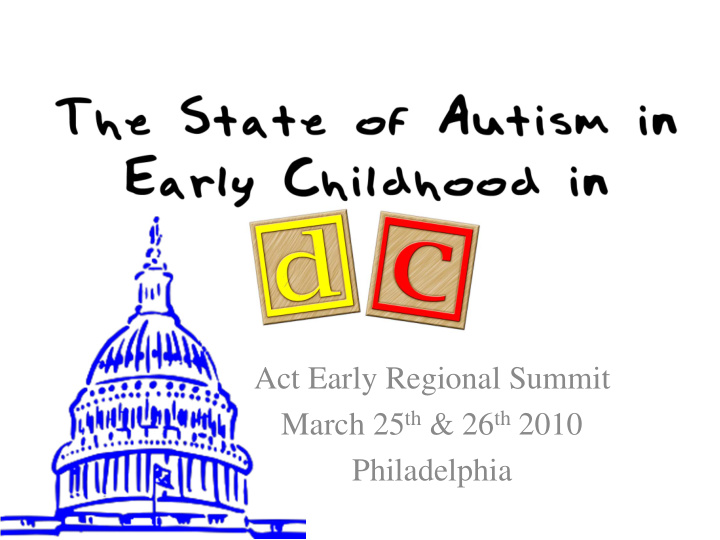



Act Early Regional Summit March 25 th & 26 th 2010 Philadelphia
DC ’ s Demographics • DC ’ s “ split city ” • Problematic age of identification in DC • Rates of identification over time: Graph source: fightingautism.org
DC ’ s Part C Program The DC Early Intervention Program (DC EIP) • Single point of entry for infants and toddlers whose families have concerns about their development • Children can receive services at home, in a licensed childcare center, or early intervention programs designed to serve children with delays
DC ’ s Part C Program: Funding • DC EIP annual budget = $2.2 million in federal funding. • Evaluations & Service Coordination = No cost to the family • D.C. Medicaid, private insurance and sometimes families pay for other services • Sliding fee scale when financial assistance is requested
Identification of Children with Special Needs • Office of the State Superintendent of Education (OSSE) identifies infants from birth to 3 years of age (Part C); EIP is newly under the umbrella of OSSE in DC • The District of Columbia Public Schools (DCPS) + DC Public Charter Schools identify children 3-21. (including children not attending public school, out- of-state children attending private school in DC)
Public Diagnostic Clinics Serving Young Children DCPS Early Stages Center • Free, comprehensive diagnostic testing facility; evaluates children 3 to 5 years old + identifies school readiness services • Available to all DC families, regardless of whether or not the child is currently enrolled in a preschool or childcare facility
Private Diagnostic Clinics Serving Young Children • CASD: Center for Autism Spectrum Disorders, Children ’ s National Medical Center • The Autism and Communication Disorders Clinic, Georgetown University Medical Center Child Development Clinic, Children ’ s National Medical Center • (serving children 0-3) – Interdisciplinary clinical approach – Children served under certain kinds of public insurance (Medicaid)
• Interagency Coordinating Council (ICC) - – Recently reconstituted, federally mandated – Parent led, independent body advising OSSE + office of the Mayor on early intervention services for Infants and Toddlers • Statewide trainings – Ongoing training + professional development for Public School clinicians and teachers through the DCPS Autism program – Annual symposia + seminars by the Georgetown UCEDD: free + open to the public – DC LEND Training Program, ASD Specialization: Children ’ s National Medical Center – Outreach program by the Ivymount School – Monthly trainings, speakers, and webinars presented by family advocacy organizations (DC Autism Parents, Autism Speaks)
Family-focused advocacy groups • DC Autism Parents (DCAP) • Family Voices of DC • Autism Society of America, District of Columbia Chapter • Autism Speaks, National Capitol Area
Insurance coverage – Law 16-198, the “ Health Insurance Coverage for Habilitative Services for Children Act of 2006. ” • coverage for habilitative services for children with developmental disabilities, including ASDs • Services covered include OT, PT, Speech & Language • No coverage for services provided through school or early intervention system (DC ST § 31-3271) – Limited coverage may be available through mental health parity act (according to Easter Seals, 2010); may be controversial
• Advocacy efforts for an Autism Waiver – Proposed Medicaid Home and Community Based Services Waiver • Health Insurance for Children with Autism Act of 2009 – Introduced by DC Council Members Wells, Bowser, + Catania, November 2009 – Would require coverage for diagnosis + evidence- based, medically necessary treatment of ASDs, including applied behavior analysis – Testimony about the bill: 3/24/2010
• Problems with early identification: Lack of awareness among primary care providers and parents of young children about ASDs • Need for capacity building: Scarcity of professionals/clinicians trained in diagnosis + intervention of ASDs • Gaps in clinical services for children: Lack of easily accessible, intensive services for children with ASDs, aged 0-3 (long lags to diagnosis, then delivery of services in public system; limited school placement options) • Difficulty supporting families: Need for improved access/availability of services for families with children with ASDs (family support, services for siblings, behavior mgt., training for parents on implementing interventions)
• Economic Barriers: Insurance and Medicaid restrictions • Lack of information: Lack of population data + local research on prevalence rates by government entities • Racial, ethnic, + socioeconomic disparities : Striking inequity in access to intensive services; lack of outreach to cultural and linguistic groups • Interagency Coordination: Difficulty coordinating services and policy across fragmented systems
Impact statement • Goal: 80% of the DC population, across diverse cultural and linguistic groups will be made aware of ASDs • Improved identification of children with ASDs, combined with improved access to ASD-specific early intervention • Increased access to evidence-based practices in the assessment and treatment of ASDs • Reduce economic barriers (reduction of insurance exclusions, waiver) • Create a family-driven, fully functional system of care for children with Autism and their families in DC
Recommend
More recommend